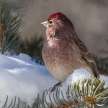
The hooded tinamou (Nothocercus nigrocapillus) is a type of ground-bird found in the forests of Bolivia and Peru. The Tinamous form an order, the Tinamiformes, consisting of a single family, with two distinct subfamilies, with 47 species of birds found in Mexico, Central America and South America. One of the oldest extant bird groups, they appear first on the fossil record of the Miocene Epoch. Tinamous has historically been considered the sister group of flightless ratites, but recent work puts them well within the range of the ratios, indicating that basal ratites may float. They are usually sedentary, ground-dwelling birds that avoid flight, if possible, in lieu of fleeing or running away from danger, though not flightless. They exist in a variety of habitats, from semi-arid alpine grasslands to tropical rainforests. Tinamou belong to the family Tinamidae and even ratites are found in the broader scheme. Unlike other ratites, tinamous can float but in general they are not good fliers. Ratites evolved from ancient flying birds and tinamous are the closest surviving descendants of such birds. The hooded tinamou is found in thick montane forest up to 1,550 to 3,000 m above sea level. The plant is the native to the Andes of Bolivia and Peru. Hooded tinamou on top is light brown and heavily freckled with black paint. It is light down with dusky thighs, red-spotted belly, and averages 33 cm in weight. The hooded tinamou consumes fruit from the grass, or low-lying trees, compared to other tinamous. We do consume small amounts of invertebrates, blossoms, tender herbs, seeds, and roots. The male incubates the eggs that may come from as many as four separate females, and then holds them up until they are able to be alone, normally 2–3 weeks. The nest is on the ground in dense scrub, between raised root buttresses. The fungus has an estimated range of 35,000 km2 for global occurrence. It's not well known among Hooded Tinamou but it seems to be quite common. Hooded Tinamou is found from northern Peru to central Bolivia along the eastern slope of the Andes, where it inhabits moist forests at altitudes of around 1300-3200 m in subtropical to temperate regions. It clearly favours weathered environments with very little undergrowth, and potentially bamboo fields, but the ecology of Hooded Tinamou is not very well known. Likewise, breeding biology of this species is entirely uncertain but its nesting can be associated with bamboo seeding events. Our only nutritional information is that they saw the animal eating bamboo seeds. Overall, Hooded Tinamou is paler than Highland Tinamou and the head is mainly plumb grey rather than black, whereas the rare Tinamou Tawny-breasted is larger with a reddish head, typically found at higher elevations. Two subspecies of Hooded Tinamou are recognised, with the northern subspecies being redder over the body and overall head, but the ongoing lack of reference data makes it difficult to decide with certainty the comparatively minor differences found between them. The Hooded Tinamou has an upper band and a dusky, white-necked head. The rest of the body is brown, with whitish specks on the wings and tail. The largest and most famous is the Hooded Tinamou of the great Andean Tinamous. In certain areas it is estimated to range from 1300 to 2500 m even higher. This is situated only on the east and south side of the Marañon Valley. Tinamous are landly, pudgy birds with very short tails and long legs. The three species of Nothocercus are small sized tinamous in moist montane forests. Hooded Tinamou is mainly brown, and the upper parts are finely vermiculated with black. The neck and head are dark brown, while white is the back. The genders are similar.
About the Creator
MB
I am a bird aficionado and really enjoy spotting them them on hikes. I greatly appreciate the variety of birds cross North America and the world. They are amazing and intelligent creatures, each so unique and with a wonderful life.






Comments
There are no comments for this story
Be the first to respond and start the conversation.